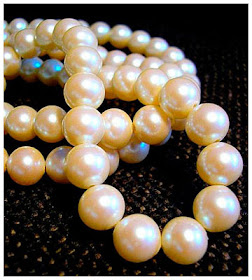It has been said that pearls are the moon to the diamond's sun. Strings of pearls have graced the necks and garments of kings and queens for centuries. This gem is not produced by the earth, but grown in the shells of simple sea creatures ... oysters and mussels. Natural sea oyster pearls are a rare commodity today. In the 1890s, Kokichi Mikimoto started commercial production of a cultured pearl, made by introducing a small mother-of-pearl bead into a farmed oyster to speed the production of a larger and more symmetrical pearl. Today, 90% of the sea oyster pearls are of the cultured variety.
But the traditional sea oyster pearl is not the only variety of pearl seen in fashion and jewelry, especially in the 20th century. Freshwater pearls and pearls from other mollusks abound. Baroque and misshapen, long and craggy, half pearls, blister pearls and black pearls have graced the jewelry of fashionistas and bargain shoppers alike.
Pearls are a featured part of the hair decoration of the lady in this 15th century painting, as well as adorning the neck of the Young Woman with a Black Cape, a 17th century portrait by Rembrandt.
Pearls symbolize purity and innocence. They seem to capture the essence of femininity, without restraining individuality. Maybe that is why they have been worn by nearly everyone from queens and princesses, first ladies and little girls, newlyweds and grandmothers.
The perfect pearl necklace is beautiful and simple. Long strings of pearls, short pearl chokers, single or multiple strands of pearls provide variety to fit any personality without giving up the simple beauty of the lustrous gems.
 |
| Vintage Cultured Pearl Strands (from $395) |
In Victorian times, and into the Edwardian era, there was a trend to use prodigious numbers of seed pearls in jewelry. These tiny pearls were hand strung on horsehair, or later thin threads of silk, onto a mother-of-pearl backing to create jewelry clustered with pearlescent luster and beaded texture. Original pieces are hard to find and somewhat fragile, but they do make a statement!Pearls of various shapes and surface textures bring a whole world of creativity to pearl jewelry for designers and collectors alike. The real winner, of course, are the ladies who love pearls and want variety beyond the traditional string of pearls.
 |
| Victorian Pearl Brooches (L: Gold-filled Grapes $85; R: 10k Gold Wishbone $89) |
 |
| Norma Dice Wire Wrapped Peas-in-the-Pod Pendants ($69 to $79 each) |
 |
| L to R: 14k Gold Keshi Pearl Earrings ($89); 14k Gold Pearl Locket ($395); 14k Gold Cultured Pearl Earrings ($95) |
There are, as you might expect, a plethora of faux pearl jewelry on the market. Some from top designers like Miriam Haskell, Hobe and Trifari are gorgeous in their own right. Mamie Eisenhower was famously in love with her Trifari pearls. Others are done so well that they almost defy distinction from the real thing. But when it comes to birthstones, only true pearls will suffice.

























